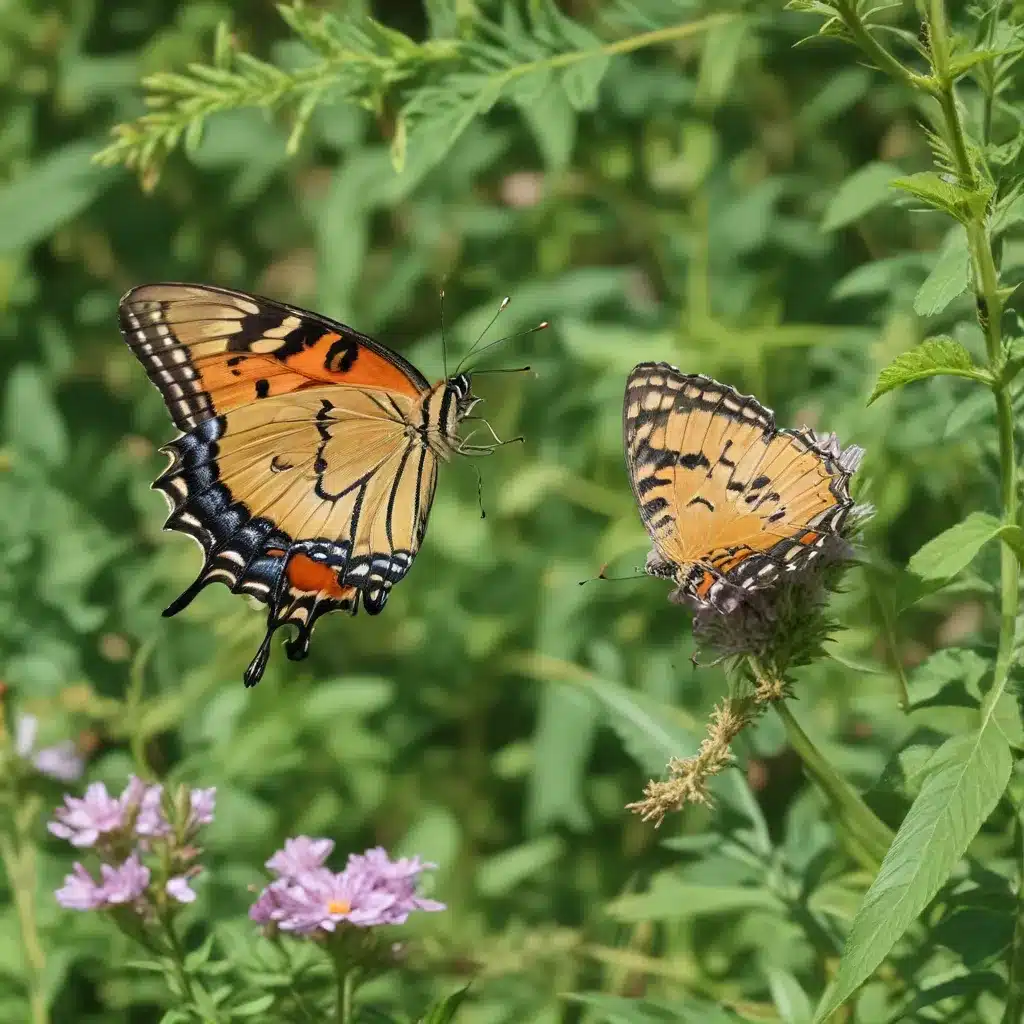
As a farm educator at Crooked Pines Farm, my goal is to help families connect with the natural wonders all around us. One of the most rewarding ways to do this is by nurturing habitats for our feathered and winged friends. Birds and butterflies not only add beauty and enchantment to the farm, but they also play pivotal roles in maintaining a healthy, thriving ecosystem.
Habitats and Landscapes
At Crooked Pines, we strive to cultivate a diverse array of environments that cater to the needs of a wide variety of wildlife. From our expansive grasslands and meadows to our shady woodlands and lush wetlands, each landscape offers unique opportunities for birds, butterflies, and other beneficial creatures to thrive.
In the open fields, we’ve planted a tapestry of native wildflowers and grasses that provide essential food and shelter for grassland species like bobolinks, meadowlarks, and native sparrows. Along the edges of these areas, where the grasslands meet the woodlands, we’ve encouraged the growth of woody shrubs and small trees – creating vital transitional zones that offer cover and nesting sites for our avian neighbors.
Our forested sections, with their towering oaks, maples, and pines, harbor a different array of bird life. Here, you’ll find woodpeckers, nuthatches, and various warbler species darting among the branches, fueling up on insects and berries. Nearby, our wetland habitats – complete with ponds, streams, and lush emergent vegetation – attract wading birds like herons and egrets, as well as waterfowl such as wood ducks and Canada geese.
Attracting Avian Visitors
The diversity of bird life at Crooked Pines is truly remarkable. Our resident species, such as northern cardinals, Carolina chickadees, and tufted titmice, can be spotted year-round, adding splashes of color and cheerful songs to the farm. But we also eagerly await the arrival of our migratory birds, which stop by during the spring and fall to refuel on their epic journeys.
To ensure our feathered friends feel at home, we’ve strategically placed bird feeders and birdbaths throughout the property. These provide essential food and water sources, especially during the lean winter months when natural resources may be scarce. We’ve also incorporated native plants that offer nectar, berries, and seeds – vital sustenance for both resident and migratory species.
Goldenrod (Solidago spp.), for example, is a farm favorite, attracting a dazzling array of insects that birds love to feast upon. We’ve planted various goldenrod species, ensuring a succession of golden blooms from late summer through fall. Other bird-friendly natives in our gardens include elderberry (Sambucus canadensis), serviceberry (Amelanchier spp.), and native sunflowers (Helianthus spp.).
Butterfly Gardening
While birds captivate us with their songs and vibrant plumages, butterflies enchant us with their graceful, fluttering dances. At Crooked Pines, we’ve made it a priority to create butterfly-friendly habitats that cater to these delicate pollinators throughout their life cycle.
Caterpillar-hosting plants, such as milkweed (Asclepias spp.) and passionflower (Passiflora spp.), provide the crucial first stage of the butterfly life cycle – the egg and larval phases. As the caterpillars hatch and grow, they feast on these plants, transforming into chrysalises that eventually emerge as stunning adult butterflies.
To sustain our butterfly population, we’ve planted a diverse array of nectar-rich annuals and perennials, ensuring a continuous supply of pollen and nectar throughout the growing season. Favorites include zinnia, lantana, butterfly bush (Buddleja davidii), and purple coneflower (Echinacea purpurea). These vibrant blooms not only delight our human visitors but also attract a kaleidoscope of butterflies, from graceful monarchs to electric-hued swallowtails.
Integrated Pest Management
While we revel in the abundance of birds and butterflies, we also understand the importance of maintaining a balanced ecosystem. At Crooked Pines, we employ organic and ecologically-sound pest management strategies that nurture beneficial insects, rather than relying on harmful chemicals.
Our pollinator gardens and wildflower patches provide essential habitat and food sources for a host of beneficial insects, including ladybugs, lacewings, and parasitic wasps. These natural pest predators help keep populations of plant-munching insects in check, reducing the need for pesticides.
We also prioritize soil health, using techniques like cover cropping, composting, and mulching to cultivate rich, fertile ground. Healthy soil not only supports vigorous plant growth but also nurtures the complex web of microorganisms that are the foundation of a thriving ecosystem.
Farm Fun and Learning
Connecting children to the natural world is a core part of our mission at Crooked Pines Farm. Through hands-on learning activities and outdoor exploration, we aim to inspire the next generation of stewards and nature enthusiasts.
One of our most popular offerings is the Farm Nature Trail, a self-guided loop that winds through diverse habitats, allowing young visitors to spot birds, butterflies, and other wildlife in their native environments. Along the way, interpretive signs and scavenger hunt challenges encourage close observation and exploration.
We also host seasonal family fun days, where children can create bird feeders, butterfly houses, and other nature-inspired crafts to take home. These activities not only cultivate creativity but also foster a deeper appreciation for the creatures that call our farm home.
Whether you’re a seasoned birder, a budding butterfly enthusiast, or simply someone who delights in the beauty of the natural world, Crooked Pines Farm invites you to come and discover the wonders of our vibrant, wildlife-friendly landscapes. By nurturing these habitats, we’re ensuring that our feathered and winged friends can continue to thrive, enriching our lives and the health of our entire ecosystem.


